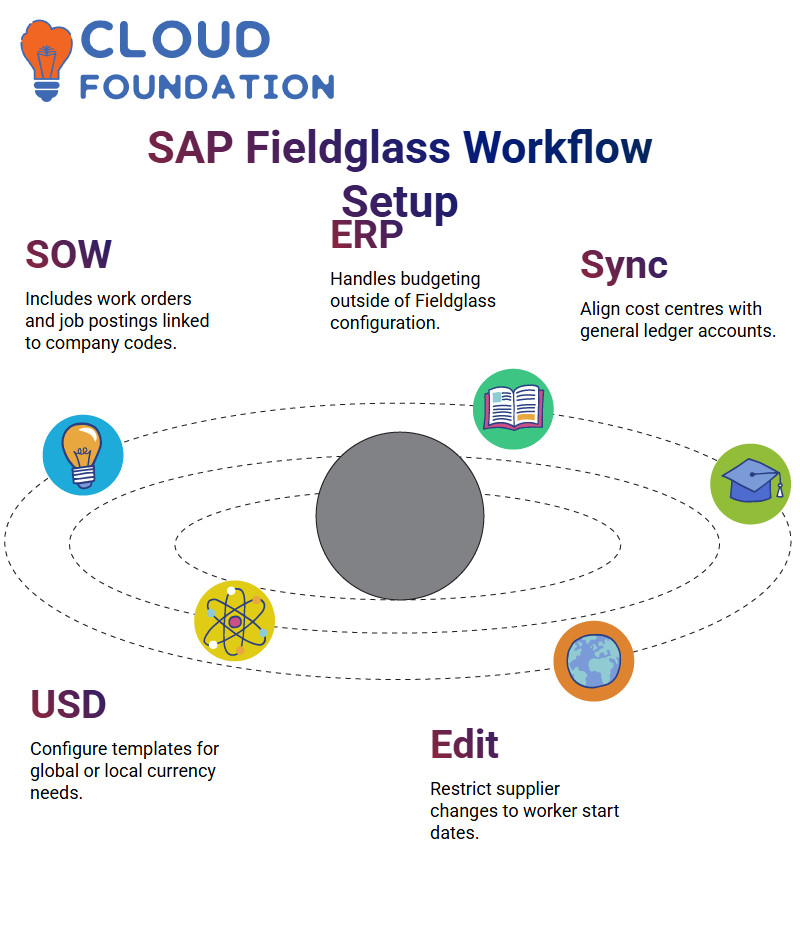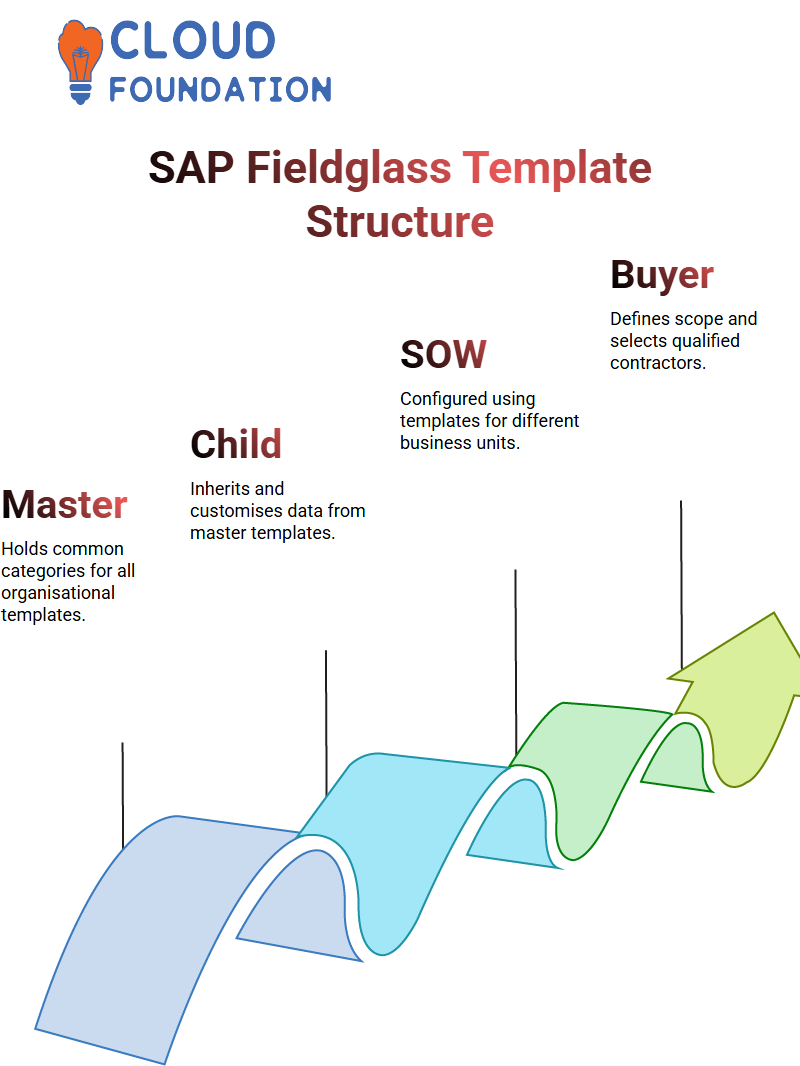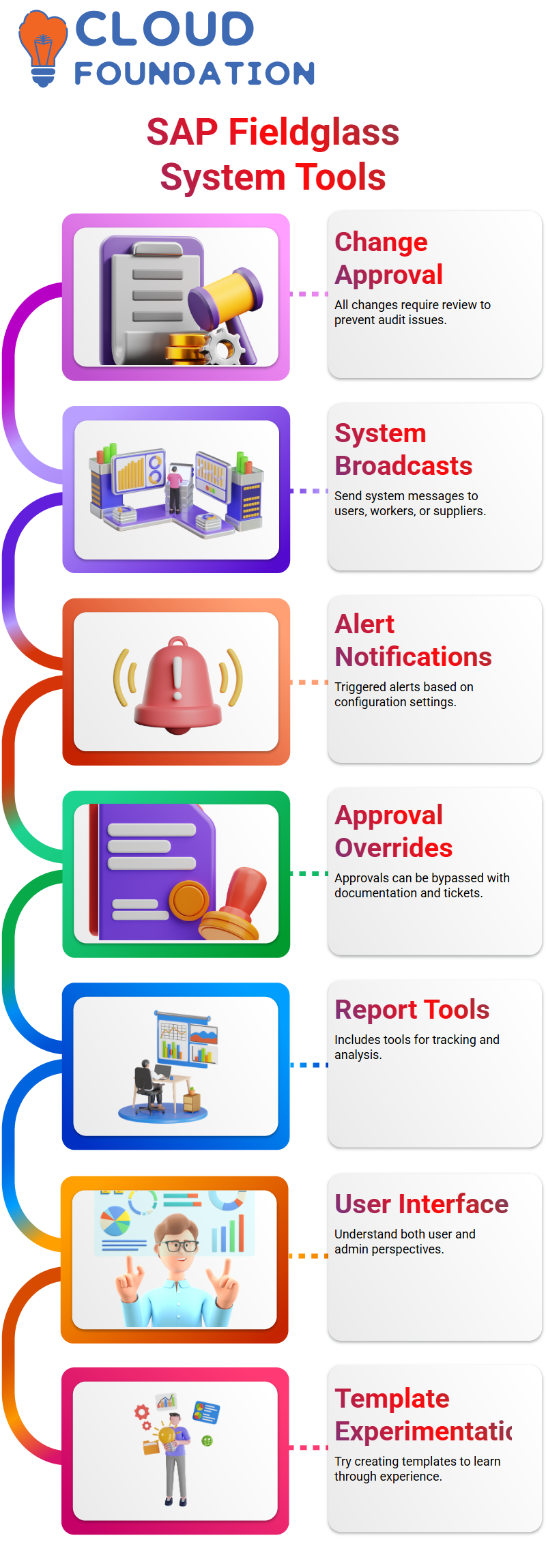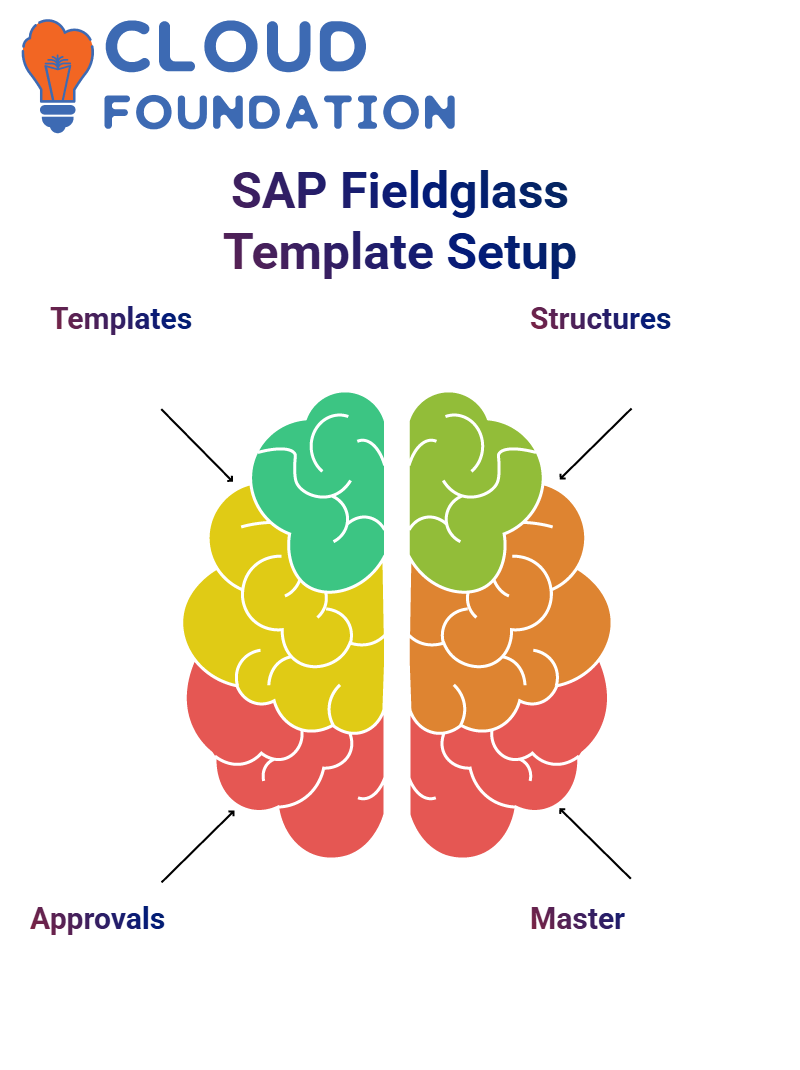SAP Fieldglass Software Training and Implementation Guide
Labor Types in Sap Fieldglass
Sap Fieldglass allows companies to assign labour types for external workers, such as administrative, clerical, accounting, finance, scientific, and industrial roles.
Unlike employee roles stored within ERP systems, contractor roles in SAP Fieldglass are only managed locally.

Sap Fieldglass ensures accurate record-keeping of these roles for seamless workforce administration.
Email Messaging Templates in SAP Fieldglass
SAP Fieldglass includes sophisticated email messaging templates. These alerts notify users about contract statuses, including contract end dates and extension options.
For instance, if an independent contractor’s term ends on July 30th, Sap Fieldglass could start sending reminders one month in advance.
Sap Fieldglass makes templates available in multiple languages and formats, featuring headers and footers to clarify their purpose. Sap Fieldglass ensures timely communication between managers and contractors.
System Variables and Messaging in SAP Fieldglass
SAP Fieldglass uses system variables to manage its messaging logic. These variables specify the reasons, modules, and recipients for every notification sent from SAP Fieldglass, whether that means informing about missed timesheet submissions or profile updates.
Sap Fieldglass ensures that all pertinent individuals receive notification as quickly as possible.As part of its implementation process, these variables are tailored to the organisation’s specific needs.
Sap Fieldglass supports either enabling or disabling notifications, allowing organisations more control over how messages are delivered to employees.
Sap Fieldglass Messaging Configuration
Messaging plays an integral part in keeping users and contractor managers up-to-date. Use the messaging options we configure in SAP Fieldglass to send notifications for various reasons, which are tracked through system variables.
My process starts by carefully considering which information needs to be distributed and which doesn’t. Understanding SAP Field Glass’s interface and flow makes this task second nature and seamless.
SAP Fieldglass Workflow Configuration Essentials
The workflow configuration in SAP Fieldglass usually, this begins with understanding contractor setup, including SOW (Statement of Work), work orders or job posting templates, which correspond with company codes and business units that represent organisational structures.
SAP Fieldglass’ budgeting practices don’t involve direct management; instead, ERP systems maintain it for us.
 Ensure cost centres and general ledger accounts are in sync, as cost allocation forms the cornerstone of financial tracking accuracy.
Ensure cost centres and general ledger accounts are in sync, as cost allocation forms the cornerstone of financial tracking accuracy.
SAP Fieldglass Template Setup Guidelines
Selecting templates in SAP Fieldglass requires careful consideration. Multiple currencies may be allowed; to avoid potential complications, ensure the template meets business needs by configuring it accordingly for any global requirements, such as USD; otherwise, keep things localised.
One essential setting involves whether suppliers can edit worker start dates. Usually, we opt to restrict editing this way because buyers should retain control; only in rare instances do we allow editing without explicit approval from buyers (SAP Fieldglass gives us this flexibility; we always prioritise buyer authority).
SAP Fieldglass Supplier Permissions
SAP Fieldglass offers options that allow suppliers to shorten or extend worker assignments as necessary, although it does not enable these by default; buyers must maintain complete control over assignment lengths to ensure accountability and prevent unexpected changes from arising.
SAP Fieldglass uses the primary contact details provided during assignment submission as the point of contact to address any issues and concerns that arise quickly.

We need to configure this in a template; everything happens automatically.
SAP Fieldglass Absence and Timesheet Management
SAP Fieldglass allows both suppliers and workers to submit absence reports. Typically, configure templates accordingly; should a worker become unavailable, their supplier steps in to submit timesheets instead, providing continuity and accurate reporting.
Attachments in SAP Fieldglass are optional but helpful. Suppliers often include job descriptions, roles, responsibilities, and resumes that provide buyers with insight to inform informed decisions when possible. Strongly suggest taking advantage of this feature.
SAP Fieldglass Best Practices for Buyers
From experiences using SAP Field Glass, I’ve come to recognise the importance of maintaining buyer control. From start dates and assignment durations to absence and report submissions, templates reflect this principle and ensure buyers’ satisfaction.
Sap Fieldglass equips buyers to manage their workforces effectively. By setting clear rules and utilising its robust features, ensure smooth operations with minimal disruptions – every configuration created takes the buyer’s best interests into account.
Understanding Characteristics in SAP Fieldglass
SAP Fieldglass makes learning characteristics an integral part of its work and will play a crucial role in configuring an SOW template.
These characteristics are exclusive to its Statement of Work module and play a vital role in its creation and maintenance.
SAP Fieldglass defines how its service companies operate within projects, using parameters such as fees, milestones, and management events as benchmarks of success.
If supporting SAP Fieldglass for Energy Australia, for example, all contractors work under an SOW that details the expectations and deliverables of everyone involved in that particular contract.
SAP Fieldglass fees represent payments made to service providers. They can either be set as flat monthly payments or tied directly to specific deliverables and events within each project phase (like planning or implementation ).
Once completed and approved by each phase, fees are released as soon as completion and approval are confirmed.
Milestones in SAP Fieldglass serve as predetermined checkpoints that help track progress. Once each milestone has been met, payment is issued to ensure accountability and transparency.
Management events do not directly correspond to payments; instead, these meetings and calls help align stakeholders and understand business needs more thoroughly.
SAP Fieldglass allows you to control visibility within templates. You decide who sees which details; some details might only be accessible to buyers, while others could be shared among suppliers based on specific parameters you define for each transaction. With such flexibility available, sensitive data is handled appropriately.
Master and Child Templates in SAP Fieldglass
SAP Fieldglass templates come in two forms, master and child. A master template houses all common categories and requirements applicable across an organisation, while child templates inherit data from it, allowing for customisation for different roles or business units.
SAP Fieldglass allows users to configure multiple SOWs using one master template, making this an invaluable feature when different business units require unique characteristics or visibility settings for SOWs.
Furthermore, buyers have complete control over creating and using such templates.

Sap Fieldglass allows buyers to customise templates according to their specific needs, whether that means specifying technical parameters or role-based requirements, offering reliable options to streamline this process and improve efficiency.
Working with SOW Workers in SAP Fieldglass
SAP Fieldglass does not use templates as the basis for its SOW employees; templates serve as guidelines defining characteristics and requirements, with the actual workers themselves being specified separately by buyers.
Buyers in SAP Fieldglass must outline technical parameters and scope to select contractors with the necessary capabilities.
Even without extensive technical knowledge themselves, buyers in this market understand desired outcomes and how best to reach them.
Once a buyer specifies their requirements in SAP Field Glass, suppliers offer potential workers for consideration.
After being chosen as candidates for onboarding to an SOW contract, these workers are officially engaged in it to ensure only qualified individuals participate.
SAP Fieldglass allows users to customise child templates by including specific requirements on top of generalised characteristics from master templates, building on the general characteristics found within.
Once these child templates have been added, they then enter an approval flow for final review by management to ensure compliance and alignment with organisational standards.
SAP Fieldglass System Tools
As soon as we make changes in SAP Fieldglass, every change must be carefully evaluated and approved before being taken into action. This helps avoid audit issues later on and offers multiple ways for recording activities.
Reaching out to their team can provide even more profound insight.System broadcasts in SAP Fieldglass can be configured to reach specific users, workers or suppliers.
Notifications triggered based on our configurations are delivered as promised.

Access to pending work items across your company is readily available. In exceptional cases, approvals may be overridden with appropriate documentation and a corresponding ticket.
Understanding SAP Fieldglass Reporting and Setup
As part of SAP Fieldglass training, we explored its reporting tools. Furthermore, we learned how to set up and create SWW work orders.
A firm grasp of its user interface enables us to think from both the user and administrator viewpoints simultaneously.
Start exploring SAP Fieldglass by experimenting. Create something in the system – even if that results in error messages – and even if that means encountering errors along the way.
For instance, creating an SWW template could be beneficial as part of this learning experience.
Configuring Rates and Budget in SAP Fieldglass
SAP Fieldglass allows you to define pay rates — daily, half-day, and quarter-day — for example, 100 Australian dollars per day, with a maximum of 150 AUD per day.
Rates can be easily changed or updated using templates, allowing users to quickly post job listings without having to start from scratch.Rate categories, rate codes and rate structures all comprise an administrative setup process.
While each of these elements from backend configuration is important for MSP roles or similar purposes, most administrators may not need to dig too deeply into them as part of a standard setup process.
Supplier Interaction and Onboarding in SAP Fieldglass
As soon as a job posting is submitted on SAP Fieldglass, it is forwarded directly to its supplier, who then responds by attaching job seekers. An MSP acts as the intermediary and shortlists candidates based on suitability criteria.
Once shortlisted, interviews are scheduled. Once selected as the chosen candidate, onboarding begins immediately as SAP Fieldglass creates a work order and assigns each worker an ID, which allows them to log in and manage time and expenses more easily.
Exploring Templates and Approval Flows in SAP Fieldglass
Creating templates in SAP Fieldglass is all about user convenience. Templates allow for faster selections and processing times, while approval flows ensure that SAP has adequately authorised every action taken by a user.
Understanding how templates and approvals are constructed provides greater insight into SAP Field Glass.
 Rate codes, grade structures and structures all feature in this configuration process; though not all aspects may be necessary for all administrators.
Rate codes, grade structures and structures all feature in this configuration process; though not all aspects may be necessary for all administrators.
Master Data and Integration in SAP Fieldglass
SAP Fieldglass relies heavily on master data. Accurate management of this data is key for smooth operations; from user profiles and cost objects, every detail matters.
Integration is another critical element. SAP Fieldglass cannot function on its own; it must interact with various platforms to function optimally.
Although integration was not addressed during this session, it remains a vast topic worth further exploration in future training programs.
SAP Fieldglass Template Creation Walkthrough
SAP Fieldglass requires one thing of us as teachers: understanding the silence in a room — where authentic learning happens. Now, let’s consider creating an SOW template in SAP Field Glass.
If you’re ready, get started by making it, beginning with a name, adding details about its creation process, and specifying its PSC code. Choose an item type, even if none appear immediately available on this template.
SAP Field Glass’ GST configuration is essential. You must determine whether GST settings should be established solely by buyers, by both buyers and suppliers, or by both parties together.
When working with master templates, less customisation may be needed, while child templates often require more complex setup—an aspect crucial in Sap Fieldglass workflows.

Imagine using a master template in SAP Field Glass: Your goal will be to avoid creating non-billable statements by associating all business units, setting the adjustment group appropriately (usually GST or equivalent), adding your currencies (start with two; you can always add more later if needed), creating clauses, some optional like SWW workers being mandatory etc, etc, all before making statements in SAP Fieldglass.
Custom Fields and Configuration in SAP Fieldglass
Custom fields in SAP Fieldglass can be created through template setup. When created, default values populate automatically.
There’s also a feature called material group; however, remember that this feature shouldn’t be used for material procurement. Even when configured, it should only be utilised if necessary.
Add management events and custom fields, but first check if any already exist before creating them in the SAP Fieldglass modules.
Due to the limited use of specific modules in SAP Fieldglass, creating rules becomes even more crucial. For instance, you can disapprove items when the budget limit has been exceeded or lock fields during creation while activating autoresponders.
Collaborators and Budget Settings in SAP Fieldglass
SAP Fieldglass makes collaboration easy. While creating your SOW document, add collaborators who can review its contents.
When setting the maximum budget amount, ensure that you do it first before locking down its computation; keep the details visible for review purposes.
SAP Fieldglass simplifies negotiation by allowing you to control budget amounts from suppliers, enabling or disallowing suppliers by toggling tracking on or off.
Discounts can also be defined and enabled when creating SOW types. Furthermore, it supports multiple suppliers and currencies, although their presence may not always be necessary.
Understanding SAP Fieldglass Revision Rules
SAP Fieldglass gives suppliers the power to initiate statement-of-work revisions. You can require approval or leave revisions open; once created, understanding all of SAP Fieldglass’s functionalities and fields will prove challenging.
SAP Fieldglass fields all have different effects and must be understood fully to achieve optimal performance. Their actions must be fully comprehended for classifications to take effect correctly, and services must adhere to a template correctly; ensure each classification aligns.

SAP Course Price


Vinitha Indhukuri
Author

